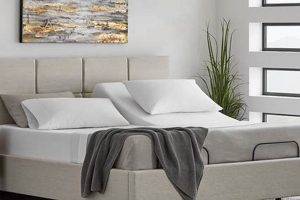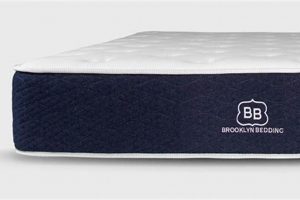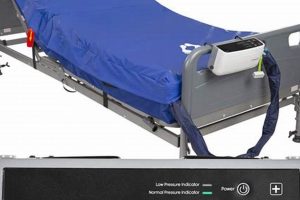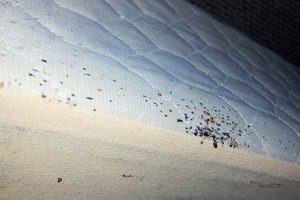Visual documentation of these pests on bedding provides concrete evidence of infestation. Examining images showing the insects, their shed skins, or fecal matter on mattresses is a crucial step in confirming their presence. Such visuals aid in distinguishing them from other household pests. For example, small, reddish-brown insects observed in mattress seams, accompanied by dark spots and molted exoskeletons, strongly suggest an infestation necessitating prompt action.
Accurate identification is paramount for effective pest management. Recognizing the signs of infestation on mattresses can prevent further spread within a dwelling and to other locations. Historically, identifying these issues relied solely on physical examination and subjective observation. However, readily available imagery enables more accessible and reliable confirmation, leading to timely intervention and reduced infestation severity.
The ability to identify infestations visually allows individuals to make informed decisions about treatment options. This understanding empowers individuals to seek professional pest control services or implement appropriate preventative measures. The following sections will detail the characteristics to look for, treatment strategies, and preventative measures related to these infestations.
Visual Identification Best Practices
Effective detection relies on careful observation and understanding of visual cues. The following recommendations enhance the utility of visual inspection for identifying infestations.
Tip 1: Employ Adequate Lighting: Utilize a bright flashlight or other focused light source to illuminate mattress seams, tufts, and crevices. Adequate lighting exposes hidden pests and their associated markings.
Tip 2: Focus on Seams and Edges: Concentrate inspection efforts on mattress seams, piping, and the areas where the mattress meets the bed frame. These locations provide harborage for the insects.
Tip 3: Scrutinize Box Springs: Extend the inspection to box springs, paying particular attention to the fabric covering and any wooden components. Infestations frequently extend beyond the mattress itself.
Tip 4: Search for Fecal Stains: Look for small, dark, reddish-brown spots on the mattress and surrounding areas. These stains are the result of digested blood and indicate active infestation.
Tip 5: Identify Shed Skins: Observe for translucent, exoskeletal remains. The presence of shed skins confirms the insects are maturing and reproducing.
Tip 6: Document Findings: Capture photographic evidence of suspected pests, shed skins, and fecal stains. Photographic documentation provides valuable information for pest control professionals.
Tip 7: Magnify Suspicious Areas: Employ a magnifying glass to closely examine small specks or markings. Magnification assists in differentiating between these pests and other debris.
Diligently applying these guidelines enhances the likelihood of early detection, which, in turn, facilitates more effective and less extensive treatment.
Implementing a proactive approach to detection minimizes the risk of widespread infestation. The subsequent sections will address comprehensive treatment options and preventive measures.
1. Early Identification
Early identification of bed bugs on mattresses, facilitated by visual evidence, is a critical determinant of successful pest management outcomes. The connection between “bed bug pictures on mattress” and early identification is one of direct causation. The presence of visual indicators, such as live insects, fecal stains, or shed skins, on bedding serves as the primary alert. This evidence prompts further investigation and, if confirmed, immediate action. Without early identification, infestations can escalate rapidly, leading to more extensive and costly treatment efforts. A real-life example would be a hotel using routine mattress inspections, documented photographically, to identify and treat isolated cases before they spread to multiple rooms.
The importance of early identification as a component of the keyword lies in its potential to mitigate the economic and health-related consequences of infestation. Delayed detection often results in increased pest populations, necessitating more aggressive treatment methods. Furthermore, prolonged exposure to bites can lead to heightened allergic reactions and psychological distress. Visual indicators observed on a mattress offer a non-invasive and readily accessible means of achieving early detection. The practical significance of this understanding is that it empowers individuals and institutions to proactively monitor their bedding, thereby minimizing the overall impact of infestations.
In summary, the visual confirmation of bed bugs on mattresses serves as a crucial catalyst for early identification. This proactive approach minimizes the extent of infestation, reduces treatment costs, and mitigates potential health consequences. Challenges in this approach include the need for careful and thorough inspections, as well as the potential for misidentification. However, the benefits of early detection far outweigh these challenges, linking directly to the broader theme of effective pest management and healthy living environments.
2. Infestation Confirmation
The phrase “bed bug pictures on mattress” serves as a critical tool for definitive infestation confirmation. While bite marks and other circumstantial evidence may suggest the presence of these pests, photographic or visual evidence provides irrefutable validation. The causative relationship is clear: observed pests, their cast skins, or fecal spotting on a mattress directly confirm infestation. Without this tangible proof, suspicion remains ambiguous, potentially leading to misdiagnosis and ineffective treatment. For instance, a tenant reporting bites might attribute them to bed bugs; photographic evidence of the insects on the mattress substantiates this claim and eliminates alternative explanations like fleas or skin irritation.
The importance of infestation confirmation within the context of “bed bug pictures on mattress” stems from its role in directing appropriate and targeted pest control measures. Mistakenly treating a non-existent infestation wastes resources and exposes individuals to unnecessary pesticide exposure. Conversely, failing to address an actual infestation allows it to proliferate, leading to greater discomfort and property damage. In a hospital setting, visual confirmation before initiating a room closure and fumigation procedure prevents disruption of services and minimizes unnecessary expense. Visual records also serve as documentation for pest control professionals, allowing for more accurate assessment of the infestation’s scope and the efficacy of treatment interventions. The practical significance lies in enabling informed decisio
n-making, ensuring resources are allocated effectively and interventions are proportionate to the actual threat.
In summary, “bed bug pictures on mattress” plays a decisive role in infestation confirmation, moving beyond speculation to provide concrete evidence. This confirmation is essential for implementing appropriate control measures, minimizing unnecessary interventions, and preventing the escalation of pest problems. While challenges exist in obtaining clear images and differentiating between bed bugs and similar insects, the benefits of visual confirmation for targeted and effective pest management are undeniable. The availability of clear images on mattresses contributes significantly to minimizing the spread and impact of bed bug infestations.
3. Treatment Guidance
Visual evidence of pests on mattresses directly informs treatment strategies. The level of infestation observable in “bed bug pictures on mattress” guides the intensity and scope of interventions. Light infestations, indicated by only a few bugs or minimal staining, may warrant localized treatments, such as targeted insecticide application or steam cleaning. Heavy infestations, characterized by numerous insects, widespread fecal matter, and shed skins, necessitate more aggressive measures, possibly including whole-room fumigation or mattress replacement. For example, a homeowner finding a single bed bug on a mattress might choose to thoroughly vacuum and encase the mattress. Conversely, a hotel discovering hundreds of bugs through photographic evidence would likely engage professional pest control for extensive treatment.
The significance of treatment guidance in this context lies in minimizing both the cost and disruption associated with pest control. Accurate visual assessment prevents the overuse of pesticides in minor infestations and ensures adequate treatment in severe cases. Misjudging the infestation level can lead to ineffective treatment, allowing the population to rebound, or unnecessary chemical exposure. Photographs can also aid pest control professionals in identifying harborage areas and tailoring their approach. Additionally, images taken after treatment provide a baseline for evaluating the intervention’s effectiveness. In multi-unit dwellings, images can help determine the extent of the infestation’s spread, guiding treatment efforts to adjacent units. The practical importance is that it allows for precise and efficient pest control, preventing recurrences and minimizing environmental impact.
In summary, visual evidence of pests on mattresses is instrumental in informing appropriate treatment strategies. It enables informed decision-making, leading to efficient and cost-effective pest control efforts. The main challenge involves accurately interpreting the images and correlating them with the actual population size and harborage locations. Nonetheless, the use of images to guide treatment represents a significant improvement over relying solely on anecdotal evidence or guesswork, contributing to more effective and environmentally responsible pest management practices.
4. Spread Prevention
Visual evidence of infestation, as presented in “bed bug pictures on mattress”, directly influences spread prevention strategies. Identifying infestations early through imagery allows for immediate containment measures. The cause-and-effect relationship is straightforward: confirmed sightings of bed bugs on a mattress trigger interventions that minimize their migration to other areas. For instance, observing bed bugs on a hotel mattress prompts immediate removal and professional treatment, preventing the pests from infesting adjacent rooms or luggage. The importance of spread prevention as a component of this evidence lies in mitigating wider infestations, reducing treatment costs, and protecting public health. Failing to contain an infestation can lead to widespread problems, affecting multiple residences or commercial spaces, as seen in apartment complexes where unchecked infestations spread rapidly through shared walls and ventilation systems.
Utilizing “bed bug pictures on mattress” enables informed decisions regarding isolation and treatment protocols. Early visual confirmation can dictate the need for mattress encasements, thorough vacuuming, and professional pest control. In healthcare facilities, this visual confirmation could trigger strict quarantine procedures for affected rooms. Such measures prevent the inadvertent transport of bed bugs on clothing, luggage, or furniture. Furthermore, post-treatment imagery verifies the effectiveness of eradication efforts and confirms that spread has been successfully contained. Educational initiatives can benefit from utilizing these images to train housekeeping staff and residents on identifying and reporting potential infestations, thereby enhancing proactive spread prevention.
In summary, “bed bug pictures on mattress” is instrumental in enabling proactive spread prevention measures. Early visual confirmation leads to prompt isolation and treatment, minimizing the potential for wider infestations. Challenges include accurately interpreting the images and coordinating effective containment strategies. However, the benefits of early detection and targeted intervention significantly outweigh the difficulties, contributing to more effective pest management and the protection of living and working environments.
5. Damage Assessment
The evaluation of harm resulting from infestations relies heavily on visual evidence captured in “bed bug pictures on mattress.” These images provide crucial insights into the extent of the infestation and the potential damage inflicted upon mattresses and surrounding areas. Thorough assessment is critical for determining appropriate remediation strategies and cost estimations.
- Stain Evaluation
Photographic evidence of fecal stains and blood spots on mattresses allows for quantifying the extent of soiling. This evaluation informs decisions regarding cleaning or replacement. Extensive staining may render a mattress unsalvageable, necessitating its disposal. For example, a heavily stained mattress in a rental property might require replacement, impacting property management budgets.
- Material Degradation Analysis
Close-up images can reveal physical damage to mattress fibers and seams caused by these pests. This degradation assessment informs the long-term viability of the mattress. For example, visible tears or weakened seams documented in pictures would indicate compromised structural integrity, potentially requiring reinforcement or replacement.
- Infestation Level Correlation
The density of pests depicted in imagery directly correlates to the duration and severity of the infestation, thereby influencing the level of damage inflicted. A high concentration of bed bugs suggests prolonged feeding and potential allergic reactions in occupants. This correlation informs medical evaluations and remediation strategies.
- Collateral Damage Identification
Visual documentation extends beyond the mattress itself to encompass surrounding areas, such as bedding, headboards, and carpets. Identifying collateral damage is crucial for comprehe
nsive remediation. For instance, bed bug spotting observed on nearby furniture in photographic evidence necessitates treatment of these items to prevent re-infestation.
These facets demonstrate the integral role of “bed bug pictures on mattress” in conducting a comprehensive damage assessment. The visual evidence informs decision-making related to cleaning, repair, replacement, and overall pest management strategies, ultimately contributing to effective remediation and mitigation of future infestations.
6. Peace of Mind
The availability of visual evidence concerning potential infestation on mattresses directly affects individuals’ psychological well-being. The phrase “bed bug pictures on mattress” is intrinsically linked to reassurance or conversely, heightened anxiety, depending on the context. Confirmatory imagery following suspected infestation provides definitive answers, enabling informed action rather than prolonged uncertainty. If the visual assessment confirms the absence of pests, it alleviates stress and allows resumption of normal activities without lingering unease. Conversely, a positive identification prompts targeted intervention, which, while initially distressing, ultimately contributes to long-term security.
The significance of peace of mind as an outcome of “bed bug pictures on mattress” lies in its impact on sleep quality, mental health, and overall quality of life. The anxiety associated with suspected infestations can manifest as insomnia, heightened vigilance, and diminished relaxation. Clear visual evidence, whether positive or negative, empowers individuals to regain control over their environment. In a case study, a family experiencing unexplained bite marks attributed them to various sources. Upon photographic inspection of their mattresses, no pests were detected, leading to the identification of an unrelated skin condition and a restoration of peace of mind within the household. The practical significance of this is the promotion of proactive investigation rather than prolonged anxiety and misinformed assumptions.
In summary, “bed bug pictures on mattress” serves as a tool for managing anxiety and promoting informed decision-making. The provision of clear visual evidence, regardless of the outcome, offers a tangible means of addressing concerns related to potential infestations. Challenges in this approach include the possibility of misinterpreting images or neglecting underlying causes. However, the value of visual confirmation in restoring a sense of security and facilitating prompt action remains substantial, linking directly to the broader theme of maintaining healthy and stress-free living environments.
Frequently Asked Questions
The following questions address common concerns and misconceptions regarding visual identification and assessment of potential bed bug infestations on mattresses.
Question 1: What constitutes conclusive evidence in “bed bug pictures on mattress”?
Conclusive evidence includes clear images of live bed bugs, their shed skins (exuviae), or fecal stains (small, dark spots of digested blood) directly on the mattress. Unclear images or suspected stains without additional supporting evidence are not considered conclusive.
Question 2: Can pictures alone determine the severity of an infestation?
Pictures provide an indication of infestation severity. A high density of bed bugs, numerous shed skins, and extensive staining suggest a more severe infestation. However, images may not capture the full extent, as bed bugs can hide in crevices beyond immediate visual range. Professional inspection is recommended for comprehensive assessment.
Question 3: Are “bed bug pictures on mattress” sufficient for identifying the source of the infestation?
Pictures on a mattress confirm infestation, but do not pinpoint the source. Bed bugs are often introduced from external sources, such as luggage or used furniture. Thorough inspection of surrounding areas, including bedding, furniture, and walls, is necessary to locate the origin.
Question 4: Is professional pest control necessary after visual confirmation?
While some DIY treatments exist, professional pest control is strongly recommended following visual confirmation. Professionals possess the expertise and equipment to eliminate bed bugs effectively and prevent re-infestation. Incomplete treatment can lead to recurring problems.
Question 5: How soon after noticing potential indicators should “bed bug pictures on mattress” be taken?
Pictures should be taken as soon as potential indicators are observed. Early documentation facilitates prompt identification and intervention, minimizing the infestation’s spread and severity. Delaying documentation can allow the infestation to worsen, complicating treatment.
Question 6: Can any image serve as evidence, or are specific details required?
Effective images should be well-lit, in focus, and clearly depict the suspected pests or their signs. Blurry or poorly lit images are less useful. Close-up shots and images with a scale reference (e.g., a coin) aid in accurate identification. Multiple images from different angles are also beneficial.
Effective use of images is a valuable tool for identifying infestations. These findings can contribute to faster action and reduce cost and risk of further spread.
The following sections will delve into strategies for preventing infestations, including best practices for maintaining a pest-free environment.
Conclusion
The utility of photographic evidence of pests on mattresses has been thoroughly explored. The analysis reveals the integral role these images play in early identification, definitive infestation confirmation, informed treatment guidance, effective spread prevention, precise damage assessment, and the restoration of psychological well-being. The evidence underscores the reliance on visual documentation for effective management.
Given the proven value, individuals and institutions are encouraged to adopt proactive monitoring protocols incorporating routine visual inspections and photographic records. Sustained vigilance remains paramount in mitigating the economic and psychological burdens associated with these persistent infestations. The judicious application of these principles will contribute to healthier and safer living environments.



![Best Blow Up Mattress for Sofa Bed [Guide & Reviews] Organic & Natural Mattress Buyer’s Guide: Non-Toxic Sleep Solutions Best Blow Up Mattress for Sofa Bed [Guide & Reviews] | Organic & Natural Mattress Buyer’s Guide: Non-Toxic Sleep Solutions](https://mattressworldpa.com/wp-content/uploads/2025/07/th-7138-300x200.jpg)



